
Evolution
PO Box 1333
Merchantville NJ 08109, USA
Email: info@arxpub.com
 Evolution |
Evolution Publishing PO Box 1333 Merchantville NJ 08109, USA Email: info@arxpub.com |
|
|
|
||
|
ALERT!
This page is no longer being updated. Please click the link below to visit a more up-to-date version of this page. https://www.arxbooks.com/evolpub/CRE/CREseries.html |
| Volume 1: The Life of Belisarius Lord Mahon [Philip Henry Stanhope], translator (1848) Long out of print, this volume
chronicles the remarkable career of Belisarius (A.D. 505(?)-A.D.
565), the last great general of Imperial Rome. Rising from
obscure beginnings, Belisarius became the right-hand man
of the emperor Justinian I in his 6th century bid to
reconquer the lost western provinces of the Roman Empire.
In an epic sequence of campaigns, Belisarius destroyed the
Vandalic kingdom in North Africa and the Ostrogothic
kingdom in Italy but ultimately, the exhausted resources
of the weakened empire and intrigues of the imperial court
in Constantinople resulted in the undoing of the man and
much of his work. February 2006 [1848] ~ paperback ~ 265 pp. + Map ~
ISBN 978-1-889758-67-1 ~ $19.95 |
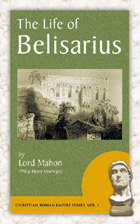 Order online and receive a 10% discount! Order for Kindle [$9.99] Order on Google Play [$15.99] |
|
Volume 3: The Liber Pontificalis is an invaluable
historical document, cataloging the names and dates of the
first 65 Pontiffs of Rome (click
here for a list) beginning with St. Peter himself.
Though of unknown authorship, its antiquity is well
established. Modern scholarship has determined that the Liber was probably
first compiled in the 6th century AD and continued
piecemeal thereafter. This English edition, originally
published in 1916, covers up through the end of the 6th
century. As such, it coincides with the rise of
Christianity from the catacombs to become the preeminent
faith of the Mediterranean world. It includes significant
biographies of many noteworthy Popes such as Sylvester,
Leo the Great, John I, and Silverius and touches upon the
reigns of secular rulers such as Constantine I, Attila,
Justinian I, and Theodoric. The Liber is a valuable source of
information on the various heresies of the early Church
and the councils called to deal with them. The work also
provides archaeological clues about the ecclesiastical
monuments of Rome, both those which survive to the present
day and those which were destroyed. |
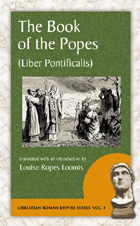 Order online and receive a 10% discount! Order on Google Play [$15.99] |
| Volume
5: The Ecclesiastical History of Evagrius A History of the Church from AD 431 to AD 594 Edward Walford, translator (1846) The Ecclesiastical History of Evagrius Scholasticus is an intriguing though neglected work of the late 6th century AD. A staunch though broadminded Chalcedonian, Evagrius styles himself as continuator of the great Church historians Eusebius, Socrates, Sozomen, and Theodoret. While never straying from his purpose, Evagrius records a great deal of information from both religious and temporal history—much of it witnessed by him personally—that would have otherwise been lost. The first section of this work deals almost exclusively with ecclesiastical issues, such as the heresy and death of Nestorius, the Council of Ephesus, the second Council of Ephesus (the so-called “Robber Council”), extensive passages on the Council of Chalcedon, the circular and counter-circular of Basiliscus, and the Henoticon of the emperor Zeno. For these important events in Church history, Evagrius is a first-class source—for some of them, he is the sole source in the original Greek. Evagrius also drew upon other contemporary historical tracts that are now either severely truncated or lost all together, including the works of Eustathius, Zachariah Scholasticus, and John of Epiphania. But what makes Evagius most interesting is his inclusion of his own eye-witness testimony. Born in the mid-530s AD in Apamea near Antioch, Evagrius witnessed the devastation of Roman Syria by the Persians and experienced first-hand the first recorded outbreak of Bubonic Plague which swept the Mediterranean world beginning in the 540s. He saw and even conversed with several of the myriad saints and scoundrels who lived in his time and he witnessed the miracles and catastrophes that occurred with astounding regularity. He is the first to record the existence of the fabled Mandylion of Edessa—a miraculous image of Christ that some have attempted to link to the Shroud of Turin. This reprint of Walford’s translation is intended for students and general readers. It has been completely re-typeset and includes a modern bibliography and recommended further reading list, as well as explanatory notes at the end of each chapter by the current editor to help bring the text up to date. 2008 [1846] ~ paperback ~ 248 pp. ~ map ~ ISBN 978-1-889758-88-6 ~ $21.95 |
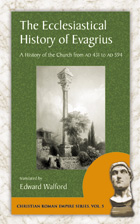 Order online and receive a 10% discount! Order for Kindle [$9.99] Order on Google Play [$17.99] |
| Volume
6: The Life of Saint Augustine A Translation of the Sancti Augustini Vita by Possidius, Bishop of Calama Herbert T. Weiskotten, translator (1919) Few figures from antiquity are as well known to us as Augustine of Hippo. Thanks to his Confessions, we know a great deal about Augustine’s life prior to his conversion to Christianity. Yet, without this little biography written by his intimate friend Possidius, bishop of Calama, we would know comparatively little about Augustine’s life after his baptism. In straight-forward, unadorned prose, Possidius shows Augustine as a powerful intellect, voluminous writer, and compelling orator, willing and able to defend the Church against all comers be they pagans, Donatists, Arians or Manichaeans. But he also presents an Augustine who humbly endured the everyday trials and difficulties of life as a bishop in Roman Africa. He shows a man who ate sparingly, worked tirelessly, despised gossip, shunned the temptations of the flesh, and exercised prudence and frugality in the financial stewardship of his see. Possidius also supplies one of the only first-hand descriptions of the great tragedy of Augustine’s life—the Vandalic conquest of Roman Africa. He poignantly describes Augustine's final illness as he lay locked inside Hippo Regius with the barbarian host literally at the city gates. More than simply the biography of a great saint, The Life of Saint Augustine provides a tantalizing glimpse into life in late Roman Africa—a prosperous society on the verge of destruction. This edition of Weiskotten's translation has been completely re-typeset for the modern reader. The text has been amended to include several corrections from an errata sheet that accompanied the original publication. It includes an expanded bibliography, updated citations, and a revised map. (Note: this edition does not include Weiskotten's revised Latin text.) 2008 [1919] ~ paperback ~ 116 pp. ~ map ~ ISBN 978-1-889758-90-9 ~ $16.95 |
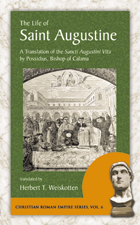 Order online and receive a 10% discount! Order for Kindle [$9.99] Order on Google Play [$13.99] |
| Volume
7: The Life of Saint Simeon Stylites A Translation of the Syriac in Bedjan’s Acta Martyrum et Sanctorum Rev. Frederick Lent, translator (1915) The Life of Saint Simeon Stylites is an intriguing primary account of the prototypical pillar saint—the first of those indefatigable holy athletes who took their stand atop a high column. Of unknown authorship, this vita was originally written in Syriac and was most likely penned shortly after Simeon’s death in AD 459. Typical of hagiographic literature of the time, Simeon’s biography is littered with tales of mystical events, miraculous cures, piety rewarded, depravity punished, divine and satanic interventions in the lives of men. But the vita also contains a wealth of information about monastic and penitential practices and provides dozens of vignettes chronicling daily Christian life and the many hardships faced by ordinary citizens of the late Roman Empire in the East. Originally published in the Journal of the American Oriental Society in 1915, this edition of Rev. Lent's English translation of Bedjan's Syriac vita has been augmented with a preface, updated bibliography, additional editorial notes, and an index. This volume also includes another article originally published in JAOS entitled, "The Letters of Simeon the Stylite." Written by Charles C. Torrey in 1899, this article offers English translations of several letters purportedly written by Simeon, along with a useful discussion of the controversy over the saint's opinion of the Council of Chalcedon. 2009 [1915] ~ paperback ~ 172 pp. ~ ISBN 978-1-889758-91-6 ~ $17.95 |
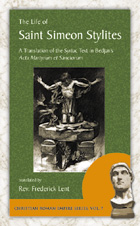 Order online and receive a 10% discount! Order on Google Play [$14.99] |
| Volume
8: The Life of the Blessed Emperor Constantine In Four Books from 306 to 337 AD by Eusebius Pamphilus Constantine the Great is one of those rare historical figures who is nearly as controversial today as he was in his own time. Lauded, both then and now, as a military hero who ended the brutal persecutions of Christians and as the first Roman emperor to himself embrace Christianity, Constantine is just as often vilified as a destructive innovator, a coddler of heretics, and a tyrannical hypocrite with the blood of his own family on his hands. The Life of the Blessed Emperor Constantine was penned shortly after the emperor’s death in AD 337 by the great Church historian Eusebius Pamphilus, bishop of Cæsarea. Though criticized as mere panegyric lionizing Constantine’s virtues while ignoring his flaws, Eusebius’s Life is nonetheless the most substantial and detailed biography of the first Christian emperor to come down to us from antiquity. The work is also the sole source for several key episodes in Constantine’s life—including the emperor’s famous vision of a cross in the sky accompanied by the words, “Conquer by this.” This anonymous translation of this important work was originally published in 1845 by Bagster and Sons. 2009 [1845] ~ paperback ~ 264 pp. ~ ISBN 978-1-889758-93-0 ~ $19.95 |
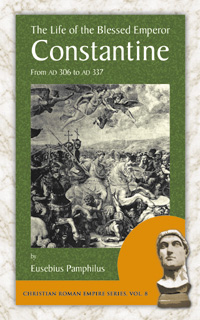 Order online and receive a 10% discount! Order for Kindle [$9.99] Order on Google Play [$15.99] |
| Volume
9: The Dialogues of Saint Gregory the Great Edited by Edmund G. Gardner Having witnessed the endless string of disasters that shattered his beloved Italy in the late 6th century AD, Pope Saint Gregory the Great set down in the Dialogues a sequence of tales to help his contemporaries escape from their worldly troubles and contemplate eternal life. Peter, Gregory’s interlocutor, laments that he has never heard of anyone famous in Italy for virtue. To set him straight, Gregory offers an entire litany of stories of Italian saints—from Honoratus of Funda who pinned a great rock to a mountainside to prevent it from crushing an abbey, to the holy virgin Tarsilla who received a vision of Pope Felix immediately before her death. Several of these stories are well known even to this day, while others, like the story of Florentius and his ill-fated bear, are merely strange and picturesque. Perhaps most importantly, Gregory’s Dialogues contain an entire book dedicated to the life of Saint Benedict of Nursia. This portion of the Dialogues represents the most detailed and lengthy biography of Benedict from a near contemporary and is the source of many of the stories told about this important saint. Often viewed as mere folk-history, the Dialogues served a higher function than simple history—they were a spiritual exhortation to Gregory’s worn and weary countrymen. To modern readers, these tales of visions, miracles and extraordinary Christian virtue paint a vivid portrait of daily life amid the wreckage of once-prosperous Roman Italy. In addition, the Dialogues offer a glimpse into the theology of one of the great minds of the Church during the time when Roman authority ebbed forever in the West and ecclesiastical authority emerged to fill the void. 2010 [1911] ~ paperback ~ 360 pp. ~ ISBN 978-1-889758-94-7 ~ $22.95 |
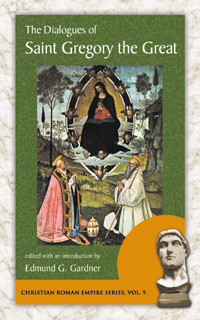 Order online and receive a 10% discount! Order on Google Play [$18.99] |
| Volume
11: The Fragmentary History of Priscus Attila, the Huns and the Roman Empire, AD 430–476 John P. Given, PhD, East Carolina University, translator “A clear, accessible and intelligent approach to the remains of this important late Roman historian and his increasingly fragmentary world.” —The Bryn Mawr
Classical Review
“For a historian, this book has appeal; for the average reader just interested in a biopsy of the fifth century CE this excellent book will be ideal-well researched, well written and accessible.” —Classical Journal Online
“Given is to be congratulated for what is, on the
whole, a very readable and useful work that one hopes will
bring Priscus to a much wider audience.”—Ancient
History Bulletin
“This is a magnificent work. It is logically organized with appropriate comments added to the translated fragments to ensure clarity and a continuous story. The author is intent on emphasizing Priscus's unique voice. In this he succeeds remarkably. Given the fragmentary nature of Priscus's work, this is no mean feat. The author's writing style is clear and lucid, and will greatly appeal to a non-specialist audience.” —Prof. Michael D. Blodgett, California
State University, Northridge
“The author has done a remarkable job situating Priscus in historical, literary and textual context. I teach a required historiography course which uses debates over barbarians as a case study. I would assign the present translation to this class without hesitation because of its clarity and its faithfulness to the spirit of the fragments.” —Prof. Mark W. Graham, Grove
City College
Attila, king of the Huns, is a name universally known even 1,500 years after his death. His meteoric rise and legendary career of conquest left a trail of destroyed cities across the Roman Empire. At its height, his vast domain commanded more territory than the Romans themselves, and those he threatened with attack sent desperate embassies loaded with rich tributes to purchase a tenuous peace. Yet as quickly he appeared, Attila and his empire vanished with startling rapidity. His two decades of terror, however, had left an indelible mark upon the pages of European history. Priscus was a late Roman historian who had the ill luck to be born during a time when Roman political and military fortunes had reached a nadir. An eye-witness to many of the events he records, Priscus's history is a sequence of intrigues, assassinations, betrayals, military disasters, barbarian incursions, enslaved Romans and sacked cities. Perhaps because of its gloomy subject matter, the History of Priscus was not preserved in its entirety. What remains of the work consists of scattered fragments culled from a variety of later sources. Yet, from these fragments emerge the most detailed and insightful first-hand account of the decline of the Roman Empire, and nearly all of the information about Attila’s life and exploits that has come down to us from antiquity. Translated by classics scholar Professor John Given of East Carolina University, this new translation of the Fragmentary History of Priscus arranges the fragments in chronological order, complete with intervening historical commentary to preserve the narrative flow. It represents the first translation of this important historical source that is easily approachable for both students and general readers. 2014 ~ paperback ~ 252 pp. + map ~ ISBN 978-1-935228-14-1 ~ $22.95 |
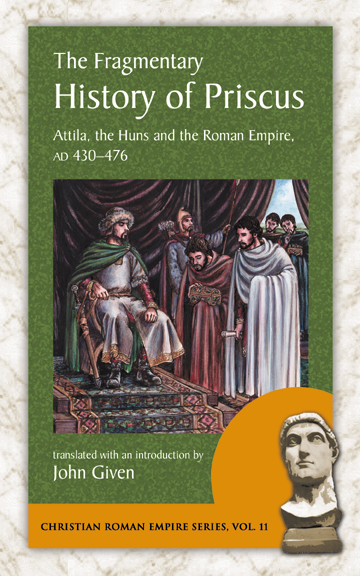 Order online and receive a 10% discount! Order for Kindle [$9.99] Order on Google Play [$19.95] |
| Volume
12: The Ecclesiastical History of Sozomen From AD 324 to AD 425 Edward Walford, translator (1855) The fourth and fifth centuries AD were an era of intense political and spiritual turmoil in the Roman world, when ancient institutions suddenly crumbled and brilliant new edifices emerged from the rubble. Covering the momentous years between AD 324 and 425, the Ecclesiastical History of Sozomen is one of the most important primary histories of this period of upheaval and transition. (Click here to access "The Quotable Sozomen".) A religious historian sympathetic to orthodoxy, Sozomen's focus is on the various quarrels, councils, schisms and reconciliations which roiled the Church at the time when Christians exited the catacombs and entered directly into the imperial administration. He provides exceptionally detailed descriptions of the heresy of Arius and the resulting religious controversies which followed the Council of Nicaea, including the recurring depositions and reinstatements of Saint Athanasius as bishop of Alexandria. With an obvious personal interest in monasticism, Sozomen provides some of the best contemporary accounts of the lives and deeds of famous monks from across the Roman world. Chronicling occurrences over the course of a century, Sozomen's History is an invaluable source on the fateful reigns of emperors such as Constantine the Great, Constantius II, Julian the Apostate, Valens, Theodosius the Great, and the empress Pulcheria. He provides anecdotes about Popes like Julius I, Liberius, and Innocent I, and great saints such as Anthony of Egypt, Ambrose of Milan, and John Chrysostom. He also includes verbatim reproductions of various ancient letters and edicts which circulated among saints, heretics and emperors as they debated the momentous religious and political questions of the age. Drawn from the elegant Bohn Ecclesiastical Library translation of 1855, this edition of Sozomen’s History has been completely re-typeset for the modern reader. Obvious typographical errors in the original text have been corrected, and punctuation has been modernized to aid with text flow. To help make the text more accessible for students and general readers, this edition also includes numerous updated explanatory notes, a current bibliography, and an index of people, places and key terms. 2018 [1855] ~ paperback ~ 412 pp. ~ ISBN 978-1-935228-15-8 ~ $29.95 |
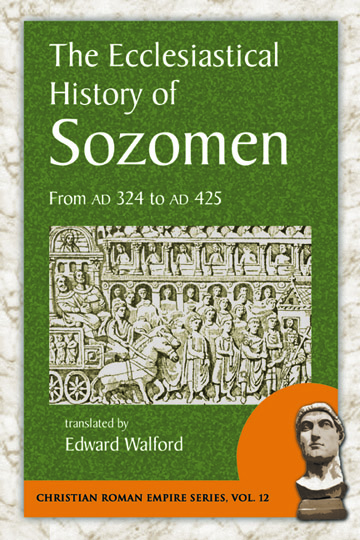 Order online and receive a 10% discount! Click here to access "The Quotable Sozomen" a collection of notable excerpts from the history. |
| Volume
13: The Life of Saint Ambrose A Translation of the Vita Sancti Ambrosii by Paulinus of Milan Sr. Mary Simplicia Kaniecka, translator Saint Ambrose of Milan is one of the towering figures of the late 4th century AD. A high official in the western Roman government, Ambrose was conscripted against his will by the people of Milan to serve as their bishop. He would go on to become one of the most important fathers of the Western Church: a fierce opponent of heretics, admonisher of emperors, voluminous writer, worker of miracles, and the spiritual father of other great saints. This biography of Ambrose was written by one of the deacons who served under him: Paulinus of Milan. Paulinus was encouraged in this biographical effort by none other than Saint Augustine of Hippo, Ambrose's most famous disciple. Written in a style similar to other works of hagiography from the same time, such as the Life of Saint Anthony by Saint Athanasius, Paulinus places Ambrose in his historical and spiritual context, drawing an enduring picture of the man and his times that has helped to cement Ambrose as one of the great holy men of the ancient Church. As a primary source, The Life of Saint Ambrose includes numerous first-hand accounts which were witnessed by Paulinus himself or related to him by those close to Ambrose. The important figures whose lives intersected with that of Ambrose included the Roman emperors Gratian, Theodosius the Great, and Valentinian II; the Arian empress Justina; usurpers Eugenius and Arbogast; the magister militum Stilicho, and saints like Marcellina, Simplicianus, Bassianus, Venerius, and many others. This version of the Vita Sancti Ambrosii was rendered into English by Sr. Mary Kaniecka in 1928. It has been completely re-typeset for the modern reader with simplified punctuation, expanded bibliography, updated citations, and an index. It retains Sr. Kaniecka's introduction and historical commentary, and includes numerous additional notes added by the modern editor. (Note: this edition does not include Sr. Kaniecka's revised Latin text nor her commentary specific to the translation.) 2019 [1928] ~ paperback ~ 96 pp. ~ ISBN 978-1-935228-19-6 ~ $16.95 |
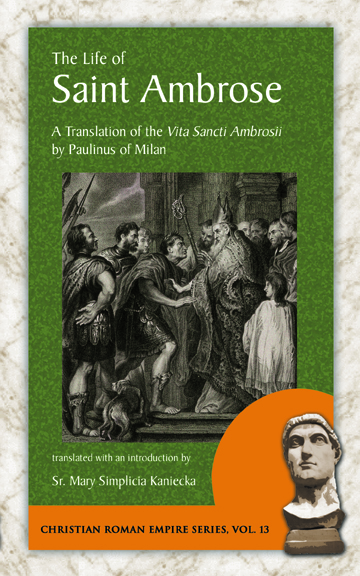 Order online and receive a 10% discount! Order for Kindle [$9.99] Order on Google Play [$13.99] |
| Volume
14: On the Deaths of the Persecutors A Translation of De Mortibus Persecutorum by Lucius Cæcilius Firmianus Lactantius Lord Hailes [David Dalrymple], translator (1782) Called the Christian Cicero by readers ancient and modern alike, Lactantius is best known for his monumental work of early Christian apologetics entitled The Divine Institutes. Though less appreciated, On the Deaths of the Persecutors is a primary source of considerable historical import containing details about the Roman Empire of the early 4th century AD that are found nowhere else. In this unique work, Lactantius created a hybrid of history and apologetics, making an argument for the truth of the Christian religion based on the fates of those emperors who had been the most egregious persecutors of Christians. Based in Diocletian's imperial capital of Nicomedia and later in Gaul at the court of Constantine, Lactantius was perfectly positioned to record these momentous events. As history, On the Deaths of the Persecutors is a key source for Diocletian’s Tetrarchy, the Great Persecution, and the rise of Constantine. It is an invaluable supplement to the broader Ecclesiastical History of Eusebius Pamphilus as well as his panegyrical Life of the Blessed Emperor Constantine, taking its place among the most important primary sources for this era of transition, turmoil and consolidation. This new edition features the classic late 18th century translation of Lord Hailes which was utilized in The Ante-Nicene Fathers series in 1905. Updated for a modern audience, the text of the translation effectively mirrors the erudite and lively prose of Lactantius's compelling and occasionally lurid historical narrative. A new introduction and extensive commentary has been added for this new edition to help make the text more approachable for the student or general reader. An index has also been included along with an updated list of references and suggested further reading. February 2021 [1782] ~ paperback ~ 128 pp. ~ ISBN 978-1-935228-20-2 ~ $16.95 |
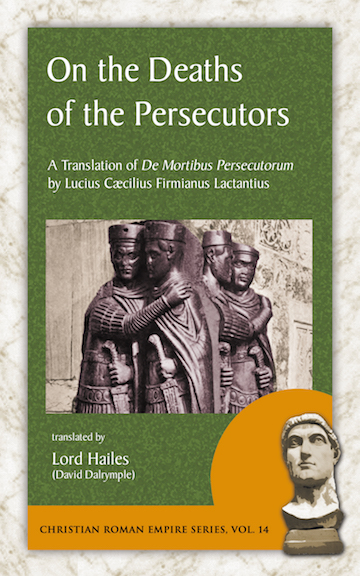 Order online and receive a 10% discount! Order for Kindle [$9.99] Order on Google Play [$14.99] |